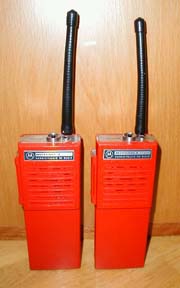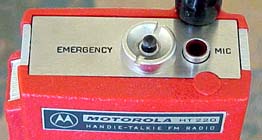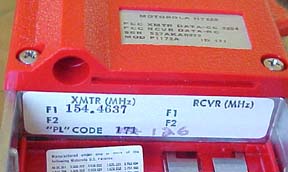

Some interesting special purpose HT220s were designed as body alarms for prison guards, executive protection, attendants in loony bins and people like that.
They are Slimline VHF HT220s with bright red plastic. No receive circuitry in them as far as I know, or at least they draw zero current. The bright red color makes them very unique looking. The *only* control on them is a shrouded momentary push button on the top of the radio. The PTT switch bar does not do anything. No power switch. There also is a shrouded red indicator light on top of the radio, viewable only by looking straight down at the radio on your belt. A few degrees off from straight down and you can't see the light.

An officer in trouble presses the momentary switch. On some radios, a squeal sounds in the portable's speaker. On some, it is silent. I don't know if these are defective or if the squeal is an option. I believe the squeal is to assist nearby officers in physically locating the officer who tripped the panic alarm.
The squeal lasts about 10 seconds, then the mic of the radio kicks in and transmits nearby audio for about 50 more seconds. During the audio transmit period, the red indicator stays lit. At the end of the timed period, the radio drops out of TX and the red indicator light goes off. Apparently the indicator is designed so no one other than the wearer of the radio can see if it is transmitting or not.
There is a companion receive console, built like a tank, extremely heavy gauge metal, absolutely super solid, far more than any other radio gear I have seen from Motorola or anyone else and I date back to the 80D mobile days with 60 amps at 6 volts for 30 watts out on low band. The receiver weighs perhaps 40 pounds.
The base station is perhaps rack width, and about 8 inches high. It has a captive 3 wire power cord on the back, fuses for line, +15VDC and -15VDC, and an SO-239 for the antenna. The one I have has no model number sticker, plate or any indication of model number, serial number or any markings whatever.
On the front on the right is a small control panel with a Sonalert, small volume and squelch knob like on the HT220, a monitor on/off toggle switch and I believe indicators for both DC voltages.
On the left are windows in 3 columns of four deep where you can write a legend for a particular channel such as a unit # or an officer's name. Each is backlit in red, and there are 12 of them. Next to each indicator is a push switch for test and reset. Some of them are momentary and some are push on/push off. I don't know why some are different.

If an officer triggers his radio, the Sonalert sounds and the appropriate indicator backlight comes on and stays lit until reset with the pushbutton next to it. The audio is heard through the local speaker. The system I have seems to work except there is low RX audio and a lot of humm on the audio which I would expect from dried out electrolytics after 30+ years.
I don't know the coding used to differentiate the various radios. All are on the same RF frequency of 160 or 170-something megacycles (I forget) which probably means they came out of federal service. [Editor's note: This particular photo showing 154 MHz is a different body alarm than what Steve has. However, you can see there is no receive frequency which is common on the Body Alarm.]
I have one receiver/alarm console, 12 portables, moldy holsters and a thoroughly beat up antique 12 slot rack charger with the toggle switches for standard or trickle charge.
Four of the 12 radios I have are coded to the receiver and they trip the receiver properly. I hope to learn how to recode the receiver or portables to all match so I can put together a complete working 12 channel system.
The rack charger I am going to strip for parts, meaning I am giving away the lamp bezels along with the extremely mildewed holsters to a fellow who sold me a service manual on the receiver.
My company does tech support for executive protection teams, amongst other things, and I had hoped to put this system back in service. The receiver, especially, is so beat up, however, I will not be able to use it professionally. I'll probably fix it up as a labor of love and sell it to someone. I've got too much in the system to toss it in the trash, and I doub anyone would want it for its original purpose unless working. The portables could be reworked to be alarm transmitters if someone would add a jack for an external alarm sensor.
I don't know how popular MOTOROLA body alarms were. In my law enforcement career I never saw them in prisons, although there were plenty of the nearly identical systems manufactured by Audio Intelligence Devices aka AID, for much higher prices undoubtedly. I could shoot some digital photos of the receiver someday if you don't have those. I allegedly have a manual coming, and maybe a scan would be better.
The local state loony bin used garage door openers, actually a commercial version made by Transcience, now probably out of business. 330 megacycles, short range especially indoors. They more hung on walls in offices than were carried. Multiple receivers tripped lights and Sonalerts in nurses' stations in adjacent wings. They relied on many receivers for coverage rather than transmit power.
Seems like UHF would have been a better choice for these panic alarms. Smaller antenna, better penetration of buildings, etc. Maybe the VHF versions came out first and the special configuration was developed early on in production.
Steve is available to producers, writers and authors for consulting on scripts, or to provide factual information on electronic surveillance, privacy protection and related technology.
http://www.business2.com/articles/mag/print/0,1643,17511,00.html
Steve is profiled in the article and quoted several times throughout, on methods of locating hostile radio commo aka bin Laden.
Steve added:
Steve Uhrig, SWS Security, Maryland (USA)
Mfrs of electronic surveillance equip
http://www.swssec.com